The Impact of Patient Navigators on Overactive Bladder Care: Real-World Practice Patterns from a US National Database
Abstract
1. Introduction
2. Materials and Methods
2.1. Study Design
2.2. Inclusion and Exclusion Criteria
2.3. Sample Size
2.4. Definition of Treatment Navigation
2.5. Outcomes
2.6. Covariates
2.7. Statistical Analysis
3. Results
3.1. Patients
3.2. Utilization of Pharmacologic Therapies
3.3. Utilization of Minimally Invasive Therapies
4. Discussion
5. Conclusions
Author Contributions
Funding
Institutional Review Board Statement
Informed Consent Statement
Data Availability Statement
Acknowledgments
Conflicts of Interest
Abbreviations
| CCP | clinical care pathway |
| OAB | overactive bladder |
| PTNS | percutaneous tibial nerve stimulation |
| SNS | sacral nerve stimulation |
Appendix A
- Definitions of discontinuation and adherence by treatment type
- Treatment adherence was defined on the basis of treatment type:
- OnabotulinumtoxinA: Returning for retreatment within 12 months of initial treatment (index date on or before 31 December 2018)
- PTNS: Receiving 12 weekly treatment visits within 4 months of the first PTNS treatment with an additional 1-week window (index date on or before 3 September 2019)
- ○
- Completion of the first treatment cycle consisted of 12 treatments within 17 weeks of the treatment start date
- SNS: Not having the SNS implant removed during the study timeline
| Term | ICD-9 Code | ICD-10 Code | Overall Population (N = 8982) n (%) a | Navigated (n = 1150) n (%) a | Non-Navigated (n = 7832) n (%) a |
|---|---|---|---|---|---|
| Hypertonicity of bladder Urinary incontinence | 596.51 788.3 788.31 788.33 788.34 788.35 788.36 788.37 788.38 788.39 | 288 (3.2) 571 (6.4) | 82 (7.1) 145 (12.6) | 206 (2.6) 426 (5.4) | |
| Urinary frequency | 788.41 | 324 (3.6) | 43 (3.7) | 281 (3.6) | |
| Polyuria | 788.42 | R35.0, R35.1, R35.8 | 2565 (28.6) | 195 (17.0) | 2370 (30.3) |
| Nocturia | 788.43 | 225 (2.5) | 18 (1.6) | 207 (2.6) | |
| Urgency of urination | 788.63 | R39.15 | 2290 (25.5) | 303 (26.3) | 1987 (25.4) |
| Functional urinary incontinence | 788.91 | R39.81 | 23 (0.3) | 8 (0.7) | 15 (0.2) |
| Overactive bladder | N32.81 | 766 (8.5) | 111 (9.7) | 655 (8.4) | |
| Urge incontinence | N39.41 | 1026 (11.4) | 147 (12.8) | 879 (11.2) | |
| Incontinence without sensory awareness | N39.42 | 46 (0.5) | 5 (0.4) | 41 (0.5) | |
| Post-void dribbling | N39.43 | 11 (0.1) | 1 (0.1) | 10 (0.1) | |
| Nocturnal enuresis | N39.44 | 92 (1.0) | 3 (0.3) | 89 (1.1) | |
| Continuous leakage | N39.45 | 12 (0.1) | 1 (0.1) | 11 (0.1) | |
| Mixed incontinence | N39.46 | 715 (8.0) | 88 (7.7) | 627 (8.0) | |
| Other specified urinary incontinence | N39.49 N39.490 N39.498 | 28 (0.3) | 0 (0.0) | 28 (0.4) |
| Overall Population (N = 8982) | Navigated (n = 1150) | Non-Navigated (n = 7832) | |
|---|---|---|---|
| Patients receiving pharmacologic treatment, n | 8427 | 1070 | 7357 |
| Initial anticholinergic, n (%) a | 4835 (57.4) | 610 (57.0) | 4225 (57.4) |
| Initial beta-3 agonist, n (%) a | 3592 (42.6) | 460 (43.0) | 3132 (42.6) |
| Patients switching b from initial pharmacologic treatment, n (%) a | 772 (9.0) | 105 (9.8) p = 0.3283 c | 667 (8.9) |
| Patients discontinuing initial pharmacologic treatment, n (%) a | 6039 (70.2) | 672 (62.5) p < 0.0001 c | 5367 (71.3) |

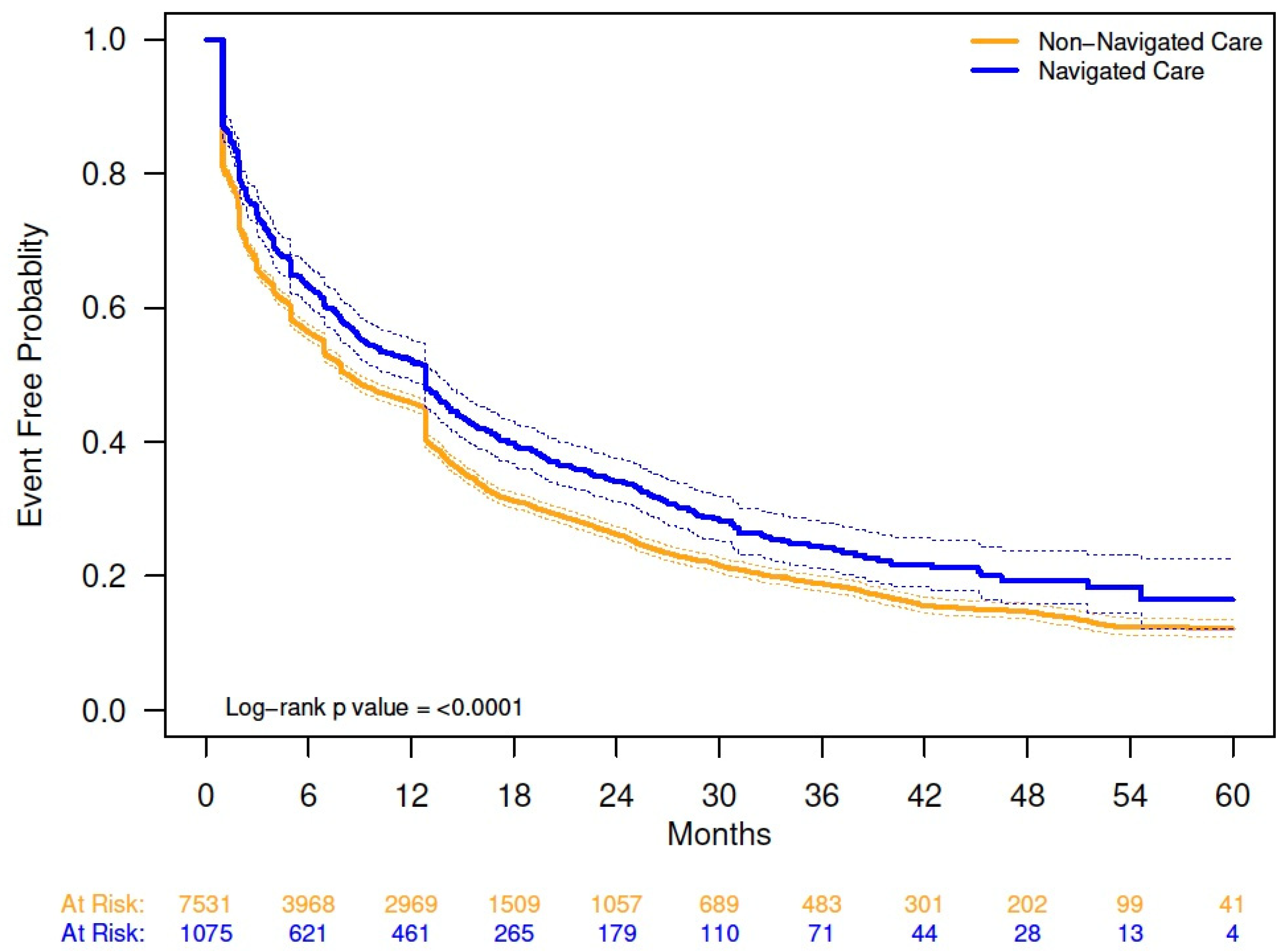
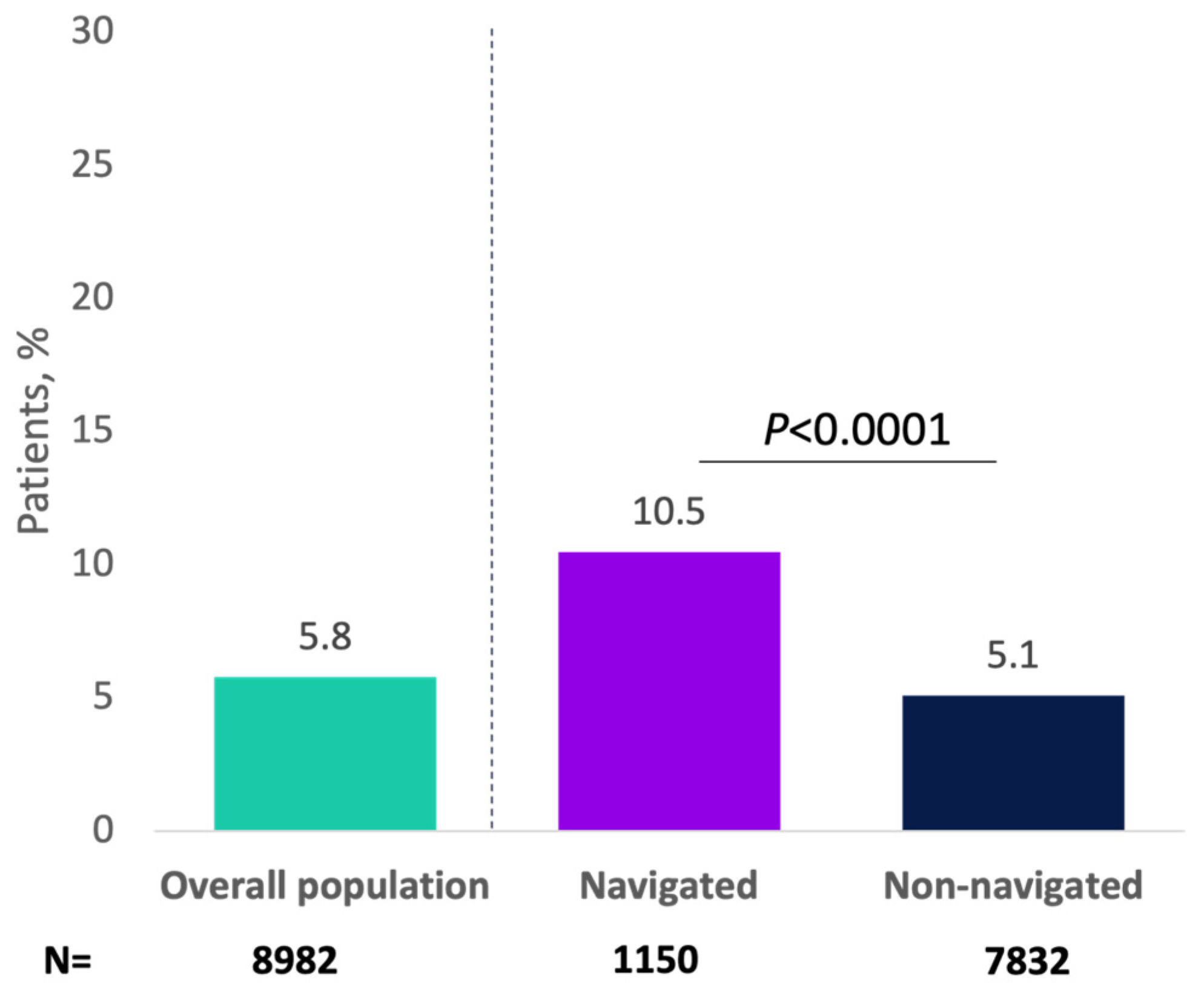
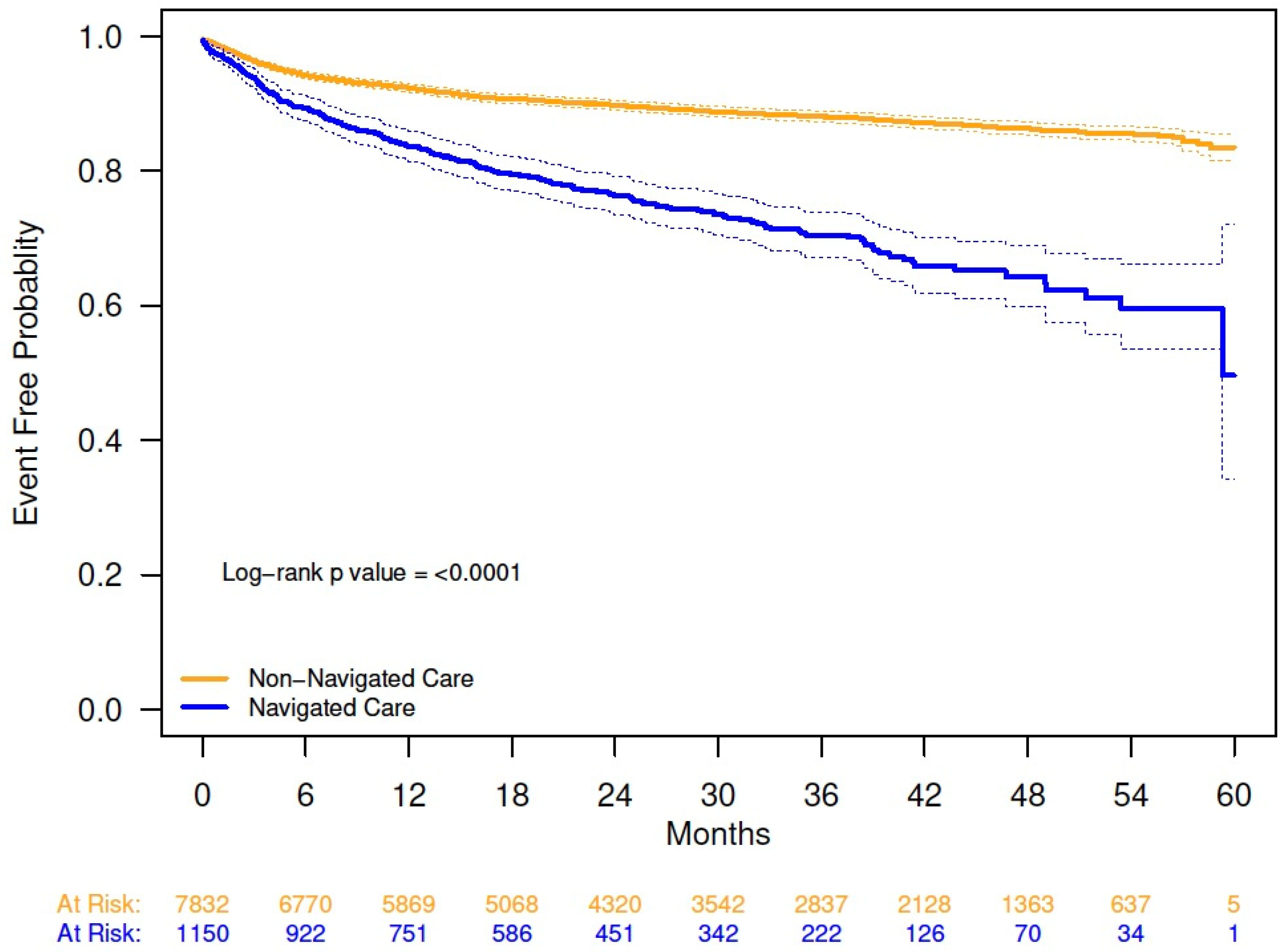
References
- Hutchinson, A.; Nesbitt, A.; Joshi, A.; Clubb, A.; Perera, M. Overactive bladder syndrome: Management and treatment options. Aust. J. Gen. Pract. 2020, 49, 593–598. [Google Scholar] [CrossRef]
- Irwin, D.E.; Milsom, I.; Hunskaar, S.; Reilly, K.; Kopp, Z.; Herschorn, S.; Coyne, K.; Kelleher, C.; Hampel, C.; Artibani, W.; et al. Population-based survey of urinary incontinence, overactive bladder, and other lower urinary tract symptoms in five countries: Results of the EPIC study. Eur. Urol. 2006, 50, 1306–1314; discussion 1314–1305. [Google Scholar] [CrossRef] [PubMed]
- Haylen, B.T.; de Ridder, D.; Freeman, R.M.; Swift, S.E.; Berghmans, B.; Lee, J.; Monga, A.; Petri, E.; Rizk, D.E.; Sand, P.K.; et al. An International Urogynecological Association (IUGA)/International Continence Society (ICS) joint report on the terminology for female pelvic floor dysfunction. Int. Urogynecol. J. 2010, 21, 5–26. [Google Scholar] [CrossRef]
- Stewart, W.F.; Van Rooyan, J.B.; Cundiff, G.W.; Abrams, P.; Herzog, A.R.; Corey, R.; Hunt, T.L.; Wein, A.J. Prevalence and burden of overactive bladder in the United States. World J. Urol. 2003, 20, 327–336. [Google Scholar] [CrossRef]
- Coyne, K.S.; Sexton, C.C.; Bell, J.A.; Thompson, C.L.; Dmochowski, R.; Bavendam, T.; Chen, C.I.; Quentin Clemens, J. The prevalence of lower urinary tract symptoms (LUTS) and overactive bladder (OAB) by racial/ethnic group and age: Results from OAB-POLL. Neurourol. Urodyn. 2013, 32, 230–237. [Google Scholar] [CrossRef]
- Lee, U.J.; Feinstein, L.; Ward, J.B.; Kirkali, Z.; Martinez-Miller, E.E.; Matlaga, B.R.; Kobashi, K.C. Prevalence of urinary incontinence among a nationally representative sample of women, 2005–2016: Findings from the Urologic Diseases in America Project. J. Urol. 2021, 205, 1718–1724. [Google Scholar] [CrossRef] [PubMed]
- Sze, E.H.; Jones, W.P.; Ferguson, J.L.; Barker, C.D.; Dolezal, J.M. Prevalence of urinary incontinence symptoms among black, white, and Hispanic women. Obstet. Gynecol. 2002, 99, 572–575. [Google Scholar] [PubMed]
- Thom, D.H.; van den Eeden, S.K.; Ragins, A.I.; Wassel-Fyr, C.; Vittinghof, E.; Subak, L.L.; Brown, J.S. Differences in prevalence of urinary incontinence by race/ethnicity. J. Urol. 2006, 175, 259–264. [Google Scholar] [CrossRef]
- Komesu, Y.M.; Schrader, R.M.; Ketai, L.H.; Rogers, R.G.; Dunivan, G.C. Epidemiology of mixed, stress, and urgency urinary incontinence in middle-aged/older women: The importance of incontinence history. Int. Urogynecol. J. 2016, 27, 763–772. [Google Scholar] [CrossRef]
- Herschorn, S. Global perspective of treatment failures. Can. Urological. Assoc. J. 2013, 7 (Suppl. S4), S170–S171. [Google Scholar] [CrossRef][Green Version]
- Helfand, B.T.; Evans, R.M.; McVary, K.T. A comparison of the frequencies of medical therapies for overactive bladder in men and women: Analysis of more than 7.2 million aging patients. Eur. Urol. 2010, 57, 586–591. [Google Scholar] [CrossRef]
- Gormley, E.A.; Lightner, D.J.; Burgio, K.L.; Chai, T.C.; Clemens, J.Q.; Culkin, D.J.; Das, A.K.; Foster, H.E.; Scarpero, H.M.; Tessier, C.D.; et al. Diagnosis and Treatment of Overactive Bladder (Non-Neurogenic) in Adults: AUA/SUFU Guideline: American Urological Association. 2019. Available online: https://www.auanet.org/guidelines-and-quality/guidelines (accessed on 19 February 2025).
- Moskowitz, D.; Adelstein, S.A.; Lucioni, A.; Lee, U.J.; Kobashi, K.C. Use of third line therapy for overactive bladder in a practice with multiple subspecialty providers—Are we doing enough? J. Urol. 2018, 199, 779–784. [Google Scholar] [CrossRef]
- Sussman, D.; Yehoshua, A.; Kowalski, J.; Lee, W.; Kish, J.; Chaudhari, S.; Murray, B. Adherence and persistence of mirabegron and anticholinergic therapies in patients with overactive bladder: A real-world claims data analysis. Int. J. Clin. Pract. 2017, 71, e12824. [Google Scholar] [CrossRef]
- Shaya, F.T.; Blume, S.; Gu, A.; Zyczynski, T.; Jumadilova, Z. Persistence with overactive bladder pharmacotherapy in a Medicaid population. Am. J. Manag. Care 2005, 11 (Suppl. S4), S121–S129. [Google Scholar]
- Wagg, A.; Compion, G.; Fahey, A.; Siddiqui, E. Persistence with prescribed antimuscarinic therapy for overactive bladder: A UK experience. BJU Int. 2012, 110, 1767–1774. [Google Scholar] [CrossRef] [PubMed]
- McBrien, K.A.; Ivers, N.; Barnieh, L.; Bailey, J.J.; Lorenzetti, D.L.; Nicholas, D.; Tonelli, M.; Hemmelgarn, B.; Lewanczuk, R.; Edwards, A.; et al. Patient navigators for people with chronic disease: A systematic review. PLoS ONE 2018, 13, e0191980. [Google Scholar] [CrossRef]
- Budde, H.; Williams, G.A.; Winkelmann, J.; Pfirter, L.; Maier, C.B. The role of patient navigators in ambulatory care: Overview of systematic reviews. BMC Health Serv. Res. 2021, 21, 1166. [Google Scholar] [CrossRef]
- Gentry, S. The Journey of Oncology Navigation: American Nurse. 13 December 2021. Available online: https://www.myamericannurse.com/the-journey-of-oncology-navigation/ (accessed on 19 February 2025).
- Aiello Bowles, E.J.; Tuzzio, L.; Wiese, C.J.; Kirlin, B.; Greene, S.M.; Clauser, S.B.; Wagner, E.H. Understanding high-quality cancer care: A summary of expert perspectives. Cancer 2008, 112, 934–942. [Google Scholar] [CrossRef] [PubMed]
- Carroll, J.K.; Humiston, S.G.; Meldrum, S.C.; Salamone, C.M.; Jean-Pierre, P.; Epstein, R.M.; Fiscella, K. Patients’ experiences with navigation for cancer care. Patient Educ. Couns. 2010, 80, 241–247. [Google Scholar] [CrossRef] [PubMed]
- Rohloff, M.; Peifer, G.; Thompson, J.H. Patient navigation for overactive bladder improves access to care. Int. Urogynecol. J. 2020, 31, 1007–1012. [Google Scholar] [CrossRef]
- Du, C.; Berg, W.T.; Siegal, A.R.; Huang, Z.; Nguyen, A.; Cheung, A.; Mehraban-Far, S.; Anderson, R.; Jacob, S.; Kim, J. A retrospective longitudinal evaluation of new overactive bladder patients in an FPMRS urologist practice: Are patients following up and utilizing third-line therapies? Neurourol. Urodyn. 2021, 40, 391–396. [Google Scholar] [CrossRef]
- Goldman, H.B.; Anger, J.T.; Esinduy, C.B.; Zou, K.H.; Russell, D.; Luo, X.; Ntanios, F.; Carlsson, M.O.; Clemens, J.Q. Real-world patterns of care for the overactive bladder syndrome in the United States. Urology 2016, 87, 64–69. [Google Scholar] [CrossRef]
- US Department of Health and Human Services. HHS Regional Offices Map. 2024. Available online: https://www.hhs.gov/about/agencies/iea/regional-offices/index.html (accessed on 19 February 2025).
- Coyne, K.S.; Sexton, C.C.; Irwin, D.E.; Kopp, Z.S.; Kelleher, C.J.; Milsom, I. The impact of overactive bladder, incontinence and other lower urinary tract symptoms on quality of life, work productivity, sexuality and emotional well-being in men and women: Results from the EPIC study. BJU Int. 2008, 101, 1388–1395. [Google Scholar] [CrossRef]
- Milsom, I.; Kaplan, S.A.; Coyne, K.S.; Sexton, C.C.; Kopp, Z.S. Effect of bothersome overactive bladder symptoms on health-related quality of life, anxiety, depression, and treatment seeking in the United States: Results from EpiLUTS. Urology 2012, 80, 90–96. [Google Scholar] [CrossRef]
- Cameron, A.P.; Chung, D.E.; Dielubanza, E.J.; Enemchukwu, E.; Ginsberg, D.A.; Helfand, B.T.; Linder, B.J.; Reynolds, W.S.; Rovner, E.S.; Souter, L.; et al. The AUA/SUFU guideline on the diagnosis and treatment of idiopathic overactive bladder. J. Urol. 2024, 212, 11–20. [Google Scholar] [CrossRef]
- Syan, R.; Zhang, C.A.; Enemchukwu, E.A. Racial and socioeconomic factors influence utilization of advanced therapies in commercially insured OAB patients: An analysis of over 800,000 OAB patients. Urology 2020, 142, 81–86. [Google Scholar] [CrossRef] [PubMed]
- Laudano, M.A.; Seklehner, S.; Sandhu, J.; Reynolds, W.S.; Garrett, K.A.; Milsom, J.W.; Te, A.E.; Kaplan, S.A.; Chughtai, B.; Lee, R.K. Disparities in the use of sacral neuromodulation among Medicare beneficiaries. J. Urol. 2015, 194, 449–453. [Google Scholar] [CrossRef]
- Luchristt, D.; Bretschneider, C.E.; Kenton, K.; Simon, M.; Brown, O. Inequities in Filled Overactive Bladder Medication Prescriptions in the US. JAMA Netw. Open 2023, 6, e2315074. [Google Scholar] [CrossRef] [PubMed]
- Duralde, E.R.; Walter, L.C.; Van Den Eeden, S.K.; Nakagawa, S.; Subak, L.L.; Brown, J.S.; Thom, D.H.; Huang, A.J. Bridging the gap: Determinants of undiagnosed or untreated urinary incontinence in women. Am. J. Obstet. Gynecol. 2016, 214, e261–e266. [Google Scholar] [CrossRef] [PubMed]
- Enemchukwu, E.A.; Subak, L.L.; Markland, A. Barriers and facilitators to overactive bladder therapy adherence. Neurourol. Urodyn. 2022, 41, 1983–1992. [Google Scholar] [CrossRef]
- Botox Cosmetic [Package Insert]; AbbVie Inc.: North Chicago, IL, USA, October 2024.
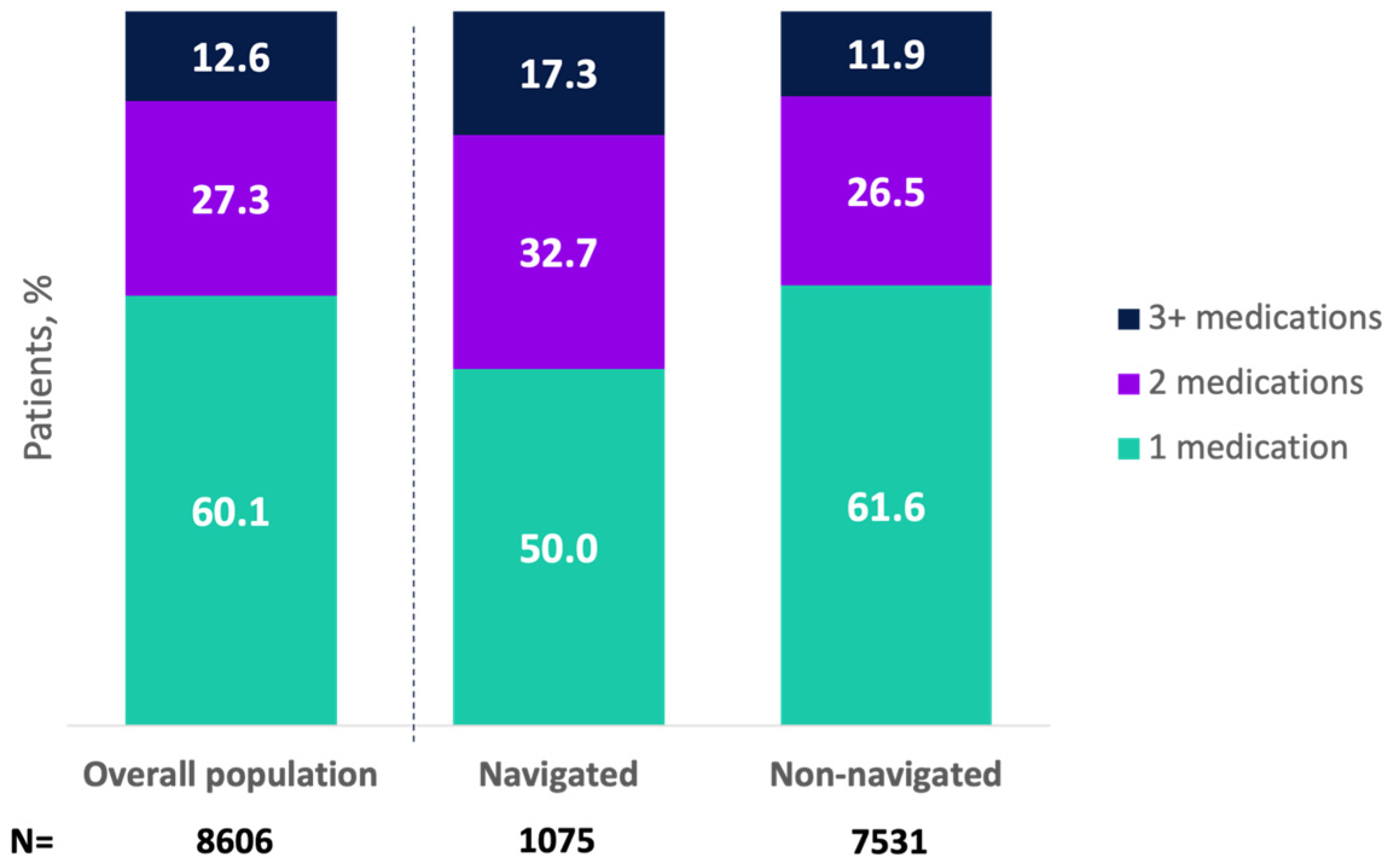
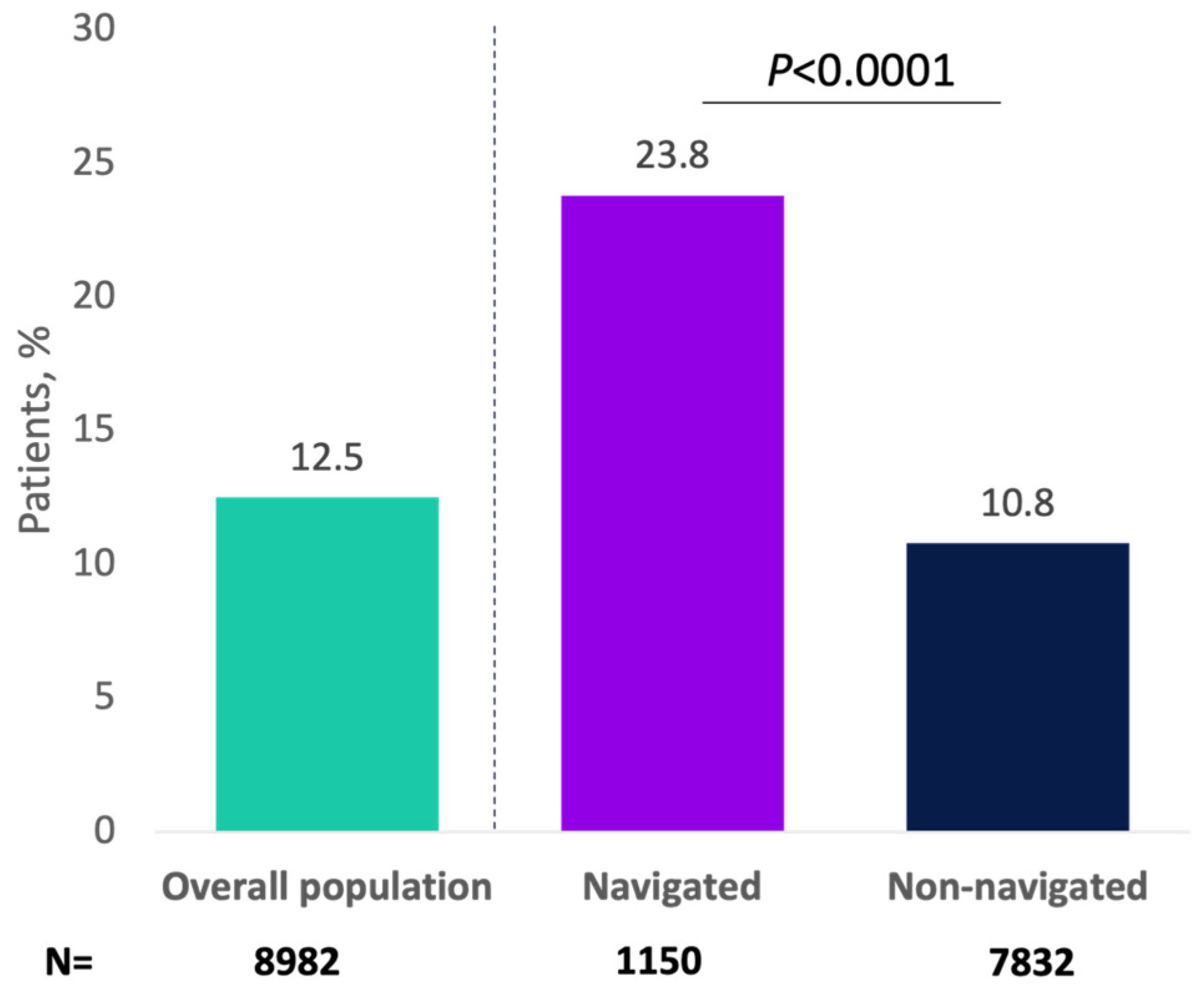
| Overall Population (N = 8982) a | Navigated (n = 1150) a | Non-Navigated (n = 7832) a | |
|---|---|---|---|
| Age at index, years | p = 0.6654 | ||
| Mean (SD) | 63.5 (16.9) | 64.0 (15.1) | 63.4 (17.2) |
| Median (25th–75th percentile) | 67.0 (55.0–75.0) | 67.0 (55.2–75.0) | 67.0 (55.0–75.0) |
| Sex, n (%) b | p < 0.0001 c | ||
| Female | 5387 (60.0) | 940 (17.4) | 4447 (82.6) |
| Male | 3594 (40.0) | 210 (5.8) | 3384 (94.2) |
| Race, n (%) | p < 0.0001 c | ||
| White | 6280 (69.9) | 817 (13.0) | 5463 (87.0) |
| Black | 930 (10.4) | 169 (18.2) | 761 (81.8) |
| Asian | 154 (1.7) | 22 (14.3) | 132 (85.7) |
| Other d | 181 (2.0) | 8 (4.4) | 173 (95.6) |
| Unknown | 1437 (16.0) | 134 (9.3) | 1303 (90.7) |
| Insurance type, n (%) | p < 0.0001 c | ||
| Medicare | 3834 (42.7) | 562 (14.7) | 3272 (85.3) |
| Private | 2501 (27.8) | 276 (11.0) | 2225 (89.0) |
| Medicaid | 328 (3.7) | 68 (20.7) | 260 (79.3) |
| Military | 60 (0.7) | 5 (8.3) | 55 (91.7) |
| Self-pay | 37 (0.4) | 4 (10.8) | 33 (89.2) |
| Other | 31 (0.3) | 3 (9.7) | 28 (90.3) |
| Unknown | 2191 (24.4) | 232 (10.6) | 1959 (89.4) |
| Medicare region, n (%) | p < 0.0001 c | ||
| 1 (Boston) | 113 (1.3) | 0 | 113 (100) |
| 2 (New York) | 848 (9.4) | 49 (5.8) | 799 (94.2) |
| 3 (Philadelphia) | 1065 (11.9) | 269 (25.3) | 796 (74.7) |
| 4 (Atlanta) | 2686 (29.9) | 283 (10.5) | 2403 (89.5) |
| 5 (Chicago) | 1365 (15.2) | 321 (23.5) | 1044 (76.5) |
| 6 (Dallas) | 1631 (18.2) | 169 (10.4) | 1462 (89.6) |
| 7 (Kansas City) | 352 (3.9) | 14 (4.0) | 338 (96.0) |
| 8 (Denver) | 284 (3.2) | 7 (2.5) | 277 (97.5) |
| 9 (San Francisco) | 424 (4.7) | 17 (4.0) | 407 (96.0) |
| 10 (Seattle) | 214 (2.4) | 21 (9.8) | 193 (90.2) |
| Patients receiving care by practice size, n (%) | p < 0.0001 c | ||
| <6 clinicians | 1401 (15.6) | 100 (7.1) | 1301 (92.9) |
| 6 to 10 clinicians | 2555 (28.4) | 167 (6.5) | 2388 (93.5) |
| 11 to 25 clinicians | 3196 (35.6) | 402 (12.6) | 2794 (87.4) |
| 26 to 50 clinicians | 982 (10.9) | 224 (22.8) | 758 (77.2) |
| >50 clinicians | 848 (9.4) | 257 (30.3) | 591 (69.7) |
| Hazard Ratio (95% CI) | p Value | |
|---|---|---|
| Navigated care, vs. non-navigated care | 2.45 (2.04, 2.94) | <0.0001 |
| Practice size, vs. <6 clinicians | ||
| 6 to 10 clinicians | 0.83 (0.65, 1.05) | 0.12 |
| 11 to 25 clinicians | 0.87 (0.69, 1.09) | 0.22 |
| 26 to 50 clinicians | 0.60 (0.43, 0.85) | <0.01 |
| >50 clinicians | 0.65 (0.44, 0.96) | 0.03 |
| Insurance type, a vs. private | ||
| Medicaid | 1.20 (0.80, 1.79) | 0.39 |
| Medicare | 1.43 (1.17, 1.74) | <0.001 |
| Military | 1.40 (0.69, 2.85) | 0.35 |
| Other | 0.82 (0.31, 2.22) | 0.70 |
| Medicare region, b vs. 4 (Atlanta, most frequent) | ||
| 1 (Boston) | 0.92 (0.49, 1.71) | 0.79 |
| 2 (New York) | 0.74 (0.52, 1.05) | 0.09 |
| 3 (Philadelphia) | 0.84 (0.58, 1.20) | 0.33 |
| 5 (Chicago) | 0.74 (0.57, 0.97) | 0.03 |
| 6 (Dallas) | 0.82 (0.65, 1.03) | 0.09 |
| 7 (Kansas City) | 0.59 (0.34, 1.04) | 0.07 |
| 8 (Denver) | 1.04 (0.71, 1.52) | 0.83 |
| 9 (San Francisco) | 1.79 (1.27, 2.52) | <0.001 |
| 10 (Seattle) | 0.77 (0.47, 1.27) | 0.31 |
| Age (years) c | 1.01 (1.00, 1.01) | 0.01 |
| Sex, female vs. male | 2.55 (2.14, 3.05) | <0.0001 |
| Race, vs. White | ||
| Asian | 0.42 (0.19, 0.94) | 0.03 |
| Black | 0.91 (0.72, 1.14) | 0.42 |
| Other | 1.25 (0.78, 2.01) | 0.35 |
Disclaimer/Publisher’s Note: The statements, opinions and data contained in all publications are solely those of the individual author(s) and contributor(s) and not of MDPI and/or the editor(s). MDPI and/or the editor(s) disclaim responsibility for any injury to people or property resulting from any ideas, methods, instructions or products referred to in the content. |
© 2025 by the authors. Published by MDPI on behalf of the Société Internationale d’Urologie. Licensee MDPI, Basel, Switzerland. This article is an open access article distributed under the terms and conditions of the Creative Commons Attribution (CC BY) license (https://creativecommons.org/licenses/by/4.0/).
Share and Cite
Enemchukwu, E.; Miles-Thomas, J.; Abraham, N.; Newman, D.K.; Schwartz, M.; Becker Ifantides, K.; Nelson, M.; Syan, R. The Impact of Patient Navigators on Overactive Bladder Care: Real-World Practice Patterns from a US National Database. Soc. Int. Urol. J. 2025, 6, 60. https://doi.org/10.3390/siuj6050060
Enemchukwu E, Miles-Thomas J, Abraham N, Newman DK, Schwartz M, Becker Ifantides K, Nelson M, Syan R. The Impact of Patient Navigators on Overactive Bladder Care: Real-World Practice Patterns from a US National Database. Société Internationale d’Urologie Journal. 2025; 6(5):60. https://doi.org/10.3390/siuj6050060
Chicago/Turabian StyleEnemchukwu, Ekene, Jennifer Miles-Thomas, Nitya Abraham, Diane K. Newman, Marc Schwartz, Kimberly Becker Ifantides, Mariana Nelson, and Raveen Syan. 2025. "The Impact of Patient Navigators on Overactive Bladder Care: Real-World Practice Patterns from a US National Database" Société Internationale d’Urologie Journal 6, no. 5: 60. https://doi.org/10.3390/siuj6050060
APA StyleEnemchukwu, E., Miles-Thomas, J., Abraham, N., Newman, D. K., Schwartz, M., Becker Ifantides, K., Nelson, M., & Syan, R. (2025). The Impact of Patient Navigators on Overactive Bladder Care: Real-World Practice Patterns from a US National Database. Société Internationale d’Urologie Journal, 6(5), 60. https://doi.org/10.3390/siuj6050060








